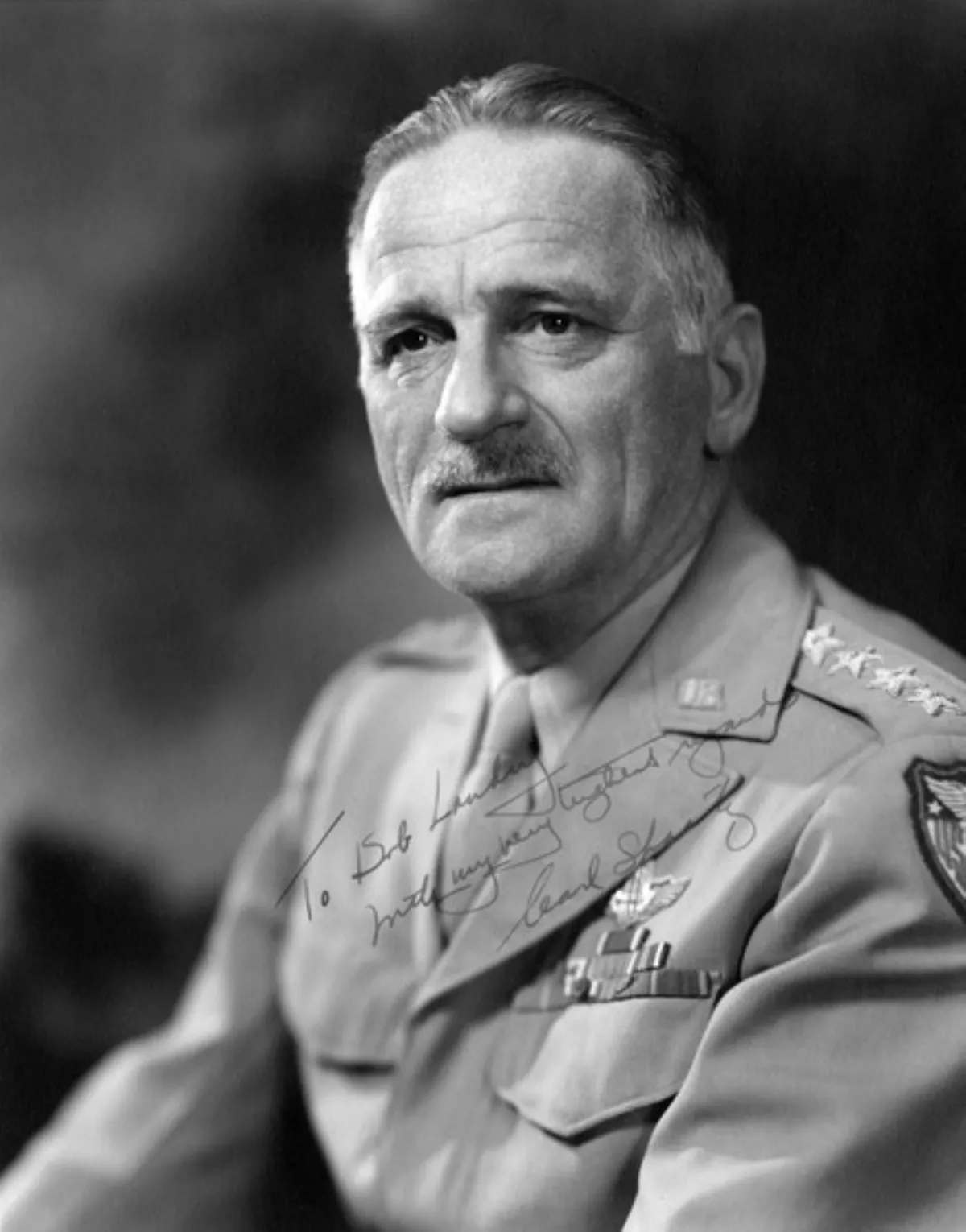 1.
1. Carl Spaatz became Chief of Staff of the newly formed United States Air Force in 1947.

 1.
1. Carl Spaatz became Chief of Staff of the newly formed United States Air Force in 1947.
Carl Spaatz's father was a state senator who ran a printing shop and a small newspaper, The Berks County Democrat, which he published from 1904 to 1930.
Carl Spaatz graduated as a second lieutenant of Infantry on 12 June 1914, ranked 97th out of a class of 107.
Carl Spaatz was detailed to the Aviation Section, US Signal Corps in Mexico on 8 June 1916, after earning his Junior Military Aviator rating.
Carl Spaatz was appointed Officer in Charge, American Aviation School at Issoudun Aerodrome, France but after receiving orders to return to the United States, he saw three weeks of action during the final months of the war with the 13th Aero Squadron as a supernumerary pilot.
In early 1919, Carl Spaatz was appointed to lead one of the three "troupes" of the US Army Air Service Victory Loan Flying Circus.
Carl Spaatz's group consisted of about twenty-five officers and fifty enlisted men.
Carl Spaatz served in California and Texas and became assistant department air service officer for the Western Department in July 1919.
Carl Spaatz experienced the chaotic ups and downs in rank common to Regular officers in 1920, when the National Defense Act of 1920 reorganized the military.
Carl Spaatz first reverted to his permanent rank of captain of Infantry on 27 February 1920.
On 18 December 1922, Carl Spaatz was discharged when Congress set a new ceiling on the number of majors authorized for the Air Service, and reappointed as a captain, then promoted again to major on 1 February 1923.
Carl Spaatz graduated from the Air Corps Tactical School, Langley Field, Virginia, in June 1925, and then served in the Office of the Chief of Air Corps at Washington, DC Later that year he testified for the defence at the court-martial of Colonel Billy Mitchell.
From 8 May 1929, to 29 October 1931, Carl Spaatz commanded the 7th Bombardment Group at Rockwell Field, California, and the 1st Bombardment Wing at March Field, California, until 10 June 1933.
Carl Spaatz then served in the Office of the Chief of Air Corps and became chief of the Training and Operations Division.
Carl Spaatz graduated in June 1936, and then served at Langley Field on the staff of Major General Frank M Andrews, commander of General Headquarters Air Force, until January 1939, when he returned to the Office of the Chief of Air Corps at Washington as assistant executive officer.
On 7 November 1939, Carl Spaatz received a temporary promotion to colonel, and during the Battle of Britain in 1940, spent several weeks in England as a special military observer.
Carl Spaatz became chief of the Plans Division of the Air Corps in November 1940, and the following July was named chief of the air staff at Army Air Forces Headquarters.
In May 1942 Carl Spaatz became commander of the Eighth Air Force and transferred its headquarters to England in July.
Carl Spaatz was placed in overall command of the USAAF in the European Theater of Operations, while retaining his Eighth Air Force command.
Carl Spaatz was promoted to the permanent rank of Major General in September 1942.
Carl Spaatz was named commander of the Allied Northwest African Air Force in February 1943, the Twelfth Air Force in March 1943, the Fifteenth Air Force, and Royal Air Forces in Italy in November 1943, and the US Strategic Air Forces in Europe in January 1944.
Carl Spaatz received a temporary promotion to lieutenant general in March 1943.
In March 1944, Carl Spaatz proposed the Oil Plan for bombing, and in June 1944 during the Operation Crossbow priority bombing of V-1 sites aimed at the UK, Carl Spaatz advocated, and received authorization from Eisenhower for, bombing of those targets at a lower priority.
Carl Spaatz received promotion to the rank of general on 11 March 1945.
From this command, Carl Spaatz directed the strategic bombing of Japan, including the atomic bombings of Hiroshima and Nagasaki.
Carl Spaatz was present at Reims when the Germans surrendered to the Americans on 7 May 1945; at Berlin when they surrendered to the Soviets on 8 May; and aboard the battleship Missouri in Tokyo Bay when the Japanese surrendered on 2 September.
Carl Spaatz was the only man of general rank or equivalent present at all three of these acts of surrender.
Carl Spaatz succeeded Arnold as Commanding General of the Army Air Forces on 11 February 1946.
Carl Spaatz retired from the military at the rank of general on 30 June 1948, and worked for Newsweek magazine as military affairs editor until 1961.
Carl Spaatz served on the Committee of Senior Advisors to the Air Force Chief of Staff from 1952 until his death; and was the first President of the Air Force Historical Foundation during 1953.
In 1954, Carl Spaatz was appointed to the congressional advisory board set up to determine the site for the new United States Air Force Academy.
Carl Spaatz died at the Walter Reed Medical Center in Washington, DC, on 14 July 1974, from congestive heart failure.
Carl Spaatz was buried at the Academy's cemetery in Colorado Springs, Colorado.
Carl Spaatz's gasoline giving out, he was forced to land and managed to land within friendly territory.